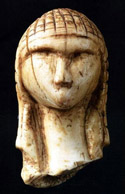Anthropology, Department of

Department of Anthropology: Faculty Publications
Document Type
Article
Date of this Version
2022
Citation
Opitz R., H. Richards-Rissetto, K. Dalziel, J. Dussault, and G. Tunink. (2022) Affording archaeological data reinterpretation: exploring 3d data reuse & repurposing through procedural modeling. In Critical Archaeology in the Digital Age, edited by Kevin Garstki, pp. 123-139. Costen Institute Press. https://escholarship.org/uc/item/0vh9t9jq
Abstract
Most contemporary 3D data used in archaeological research and heritage management have been created through ‘reality capture,’ the recording of the physical features of extant archaeological objects, structures, and landscapes using technologies such as laser scanning and photogrammetry (Garstki 2020, ch.2; Magnani et al. 2020). A smaller quantity of data are generated by Computer Aided Design (CAD) and Building Information Modeling (BIM) projects, and even fewer data are generated through procedural modeling, the rapid prototyping of multi-component threedimensional (3D) models from a set of rules (Figure 8.1.). It is unsurprising therefore that in archaeology and heritage, efforts around digital 3D data preservation and accessibility have concentrated on high-resolution 3D data produced through scanning and image-based techniques (Hardesty et al. 2020; Richards-Rissetto and von Schwerin 2017). Establishing best practices, cultivating a community of experts, and developing infrastructure for this kind of 3D data in the archaeological and cultural heritage domains have been the focus of several coordinated efforts in Europe over the past decade (Fresa et al. 2015, Remondino and Campana 2014, Taylor and Gibson 2017, Vecchio et al. 2015). A series of European projects including 3D-COFORM, CARARE, and their successor projects, made particularly notable contributions (D’Andrea et al. 2013, Kuroczyski et al. 2014, Papatheodorou et al. 2011, Pitzalis et al. 2011, Remondino and Campana 2014). These projects were primarily oriented toward 3D data captured as part of conservation and heritage management work. Issues of preservation, accuracy, fidelity, access, and associated ethical issues of ownership, stewardship, contextualization, and interpretation were, appropriately, the center of extended disciplinary debates (for example, Magnani et al. 2018, Santana Quintero et al. 2019, Ulguim 2018; and more broadly on digital ethics Dennis 2020 and Richardson 2018). File size, geometric complexity, the diversity of ‘standard’ formats, evolving platforms for delivery, and presentation online posed challenges that continue to re-emerge today (for example, Digital Lab Notebook http://culturalheritageimaging.org/ Technologies/Digital_Lab_Notebook/, Jensen 2018a, Koutsoudis et al. 2020, Münster et al. 2016, Rahaman et al. 2019, Rourk 2019). To these efforts, heritage practitioners working in the context of architecture and urban development communities added workflows and tools designed to make CAD- and BIM-produced 3D models FAIR (Findable, Accessible, Interoperable, and Reusable). Such work provides a foundation for broader efforts to make data in 3D digital archaeology and heritage FAIR (Apollonio et al. 2012, Leventhal 2018, Pocobelli et al. 2018, Saygi et al. 2013, Wilkinson et al. 2016). These CAD and BIM projects also advanced the development of archaeological information infrastructures and workflows for 3D data by incorporating more extensive use of paradata, while also grappling with issues of uncertainty and intellectual transparency in the interpretive modeling process (Bentkowska-Kafel et al. 2012, Denard 2012).
In contrast, procedural modeling’s geometrically simple, lego-like 3D models have received little attention from the community concerned with digital 3D infrastructures, standards, and practices (Coelho et al. 2020). Various sectors employ the approach to create multiple virtual reconstructions (simulations) and to explore alternative constructions and arrangements with varying properties. These multiple, nesting-doll reconstructions redeploy components such as buildings in different arrangements according to diverse rules (Figure 8.1.). In archaeology, they have been used to investigate ancient Roman, Greek, Egyptian, and Maya cities in connection with core research questions about the emergence, character, and experience of urban life (Dylla et al. 2009, Fanini and Ferdani 2011, Kitsakis et al. 2017, Piccoli 2014, 2016, 2018, Richards- Rissetto and Plessing 2015, Saldana 2014, Saldana and Johanson 2013, Sullivan 2017, 2020).
Included in
Archaeological Anthropology Commons, Architecture Commons, Computer and Systems Architecture Commons, Data Storage Systems Commons, Digital Humanities Commons, Geography Commons, History Commons, Urban Studies and Planning Commons


Comments
Copyright ©2022 Regents of the University of California. Open access.